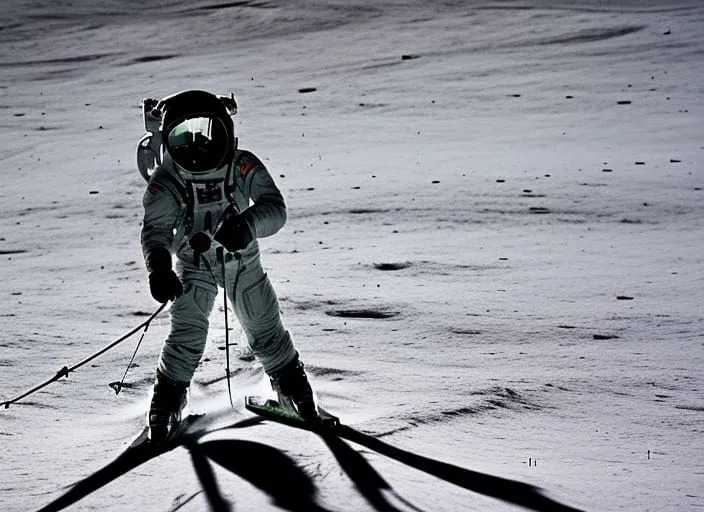
Disclaimer: I am not a physicist, nor anywhere close to it. I have a fun imagination. Today we’re going to send a line down Mons Huygens in the Montes Apenninus Mountain Range. Standing at 18,046 feet, it’s the tallest mountain on Earth’s Moon. If you thought a ski pass today is expensive, try to get to the Moon, you’re definitely going to want to carpool.
It turns out NASA has sent some shredders to space. During the Apollo 15 mission, Jim Irwin said this about their landing site on the Moon.
“Oh, boy, it’s beautiful out here! Reminds me of Sun Valley (a ski resort in Idaho),” even saying the soil underfoot was like “soft powder snow”.
Irwin referenced Mount Hadley Delta, towering 11,000+ feet above him, resembling Dollar Mountain at Sun Valley.

During the Apollo 17 mission, geologist Harrison “Jack” Schmitt said this on the potential of skiing the Moon.
“I think downhill techniques would work very well on the moon,” he says. “You even have built-in moguls, the impact craters on the slopes. Lunar gravity would allow all kinds of jumps and hops that you might find difficult on Earth.”
Skiing the Moon has been at the forefront of a few astronauts’ minds, leaving us to nerd out about it.
Let’s get to it; time to find our skis or board of choice. We will need to toughen up the base, maybe rock a Teflon-coated base or hopefully be able to demo NASA’s new high-tech skis. The moondust, unlike that champagne powder, is extremely abrasive. Think ripping down a sand dune; instead, the sand is made of a glass-rock mix. The grain size of the moondust is around 1/5 the size of a typical grain of sand, making for a slick but sharp ride.
Is today a powder day? Well, the Moon has no atmosphere (more on that if you’re interested), so we won’t get any massive storms dumping multiple feet of snow. Instead, we are going to wait thousands of years. According to Space.com, moondust takes about 1,000 years to accumulate 0.04 inches. Doing the math, if you want a nice fresh 6″, you would have to wait 150,000 years for it to accumulate. You better make every turn count while you’re up there; no free refills here!
What about lunar avalanches? Luckily we have researchers who have helped us answer this question. Studies published on AGU have been conducted to see whether the lack of gravity, moisture, or atmosphere prevents lunar avalanches. I will save you all the technical wording, but the results of the study can be found on the AGU website. Unfortunately, they discovered avalanches can still occur on the Moon, so don’t forget your avy gear.
After getting the beta on FATMAP, you have your friend fly up to the top of Mons Huygens. You eye up a gnarly spine and get ready to drop. 3…2…1…. you take off, accelerating at a snail’s pace. Moon’s gravity is 1.62 m/s², compared to Earth’s 9.81 m/s². This means there’s less force pushing you down the mountain. It looks like you should straight-line most of this run. Also, feel free to ignore the image below; I explained most of it, but for those who want to geek out, viola.

Now for the fun part! Moon’s gravity may keep you from hitting mach-5 down this run, but it sure will be fun sending that double backy off that rock. There is less force from gravity acting down on you, causing your flight time and hang time to increase.
Gravity on the Moon is 17% less than gravity on Earth, so by doing some quick math, you can probably jump around nine feet off the ground. The average vertical for someone in their 20s is approximately 18 inches (1.5 feet). Apply that to a little side hit out of a crater, and you instantly enter “X Games Mode!”
- Related: MOONTAIN SKIING – YouTube (Cinematic masterpiece!)
Is the Moon a “no-biff zone?” This question is a little more difficult to answer. Yes (for the most part), the rate at which you fall to the ground will be slower on the Moon. Yes, your relative weight on the Moon is going to be less. That darn moondust we talked about earlier is going to be a pain. Hopefully, your spacesuit is strong against that sharp wannabe pow-pow, and you have the patience to get back up to speed. So, unless you have top-tier abrasion-resistant gear, I would probably consider the Moon a no-biff zone most of the time (pokey-sharp moondust bad).
Hopefully, you enjoyed your long cruise down the mountain, hucking at least a backflip or two and avoiding a gnarly tomahawk down the mountain. After researching this, becoming an astronaut has become even cooler. Who knows, you could be the first to set tracks up there.
